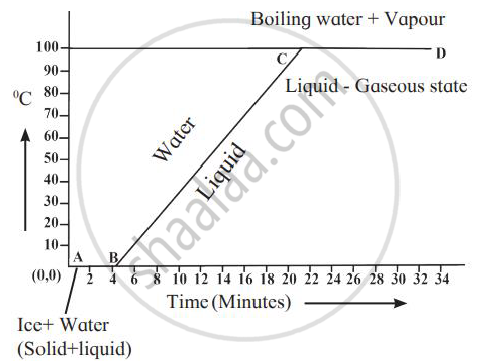Advertisements
Advertisements
प्रश्न
A molten metal of mass 150 g is kept at its melting point 800℃. When it is allowed to freeze at the same temperature, it gives out 75,000 J of heat energy.
- What is the specific latent heat of the metal?
- If the specific heat capacity of metal is 200 J kg-1 K-1, how much additional heat energy will the metal give out in cooling to -50℃?
उत्तर
- Mass of metal = 150 g
Specific latent heat of metal
L = `"Q"/"m"`
= `75000 / 150`
= 500 J g-1 - Specific heat capacity of metal is 200 J kg-1K-1.
Change in temperature= 800 − (−50)
= 850°C (or 850 K).
ΔQ = mcΔT
= 0.15 × 200 × 850
= 25500 J
APPEARS IN
संबंधित प्रश्न
State the effect of an increase of impurities on the melting point of ice.
Which has more heat: 1 g ice at 0℃ or 1g water 0℃? Give reason.
Explain the following:
The heat supplied to a substance during it change of state, does not cause any rise in its temperature.
The specific latent heat of fusion of water is ______.
What is meant by latent heat? How will the state of matter transform if latent heat is given off?
A thermally insulated pot has 150 g ice at temperature 0°C. How much steam of 100°C has to be mixed to it, so that water of temperature 50°C will be obtained? (Given : latent heat of melting of ice = 80 cal/g, latent heat of vaporization of water = 540 cal/g, specific heat of water = 1 cal/g °C)
Explain the following temperature vs time graph.

Give one consequence of the high specific latent heat of fusion of ice.
Why does weather become pleasant when it starts freezing in cold countries?
Steam at 100°C is passed over 1000 g of ice at 0°C. After some time, 600 g of ice at 0°C is left and 450 g of water at 0°C is formed. Calculate the specific latent heat of vaporization of steam (Given: specific heat capacity of water = 4200 J/kg°C, specific latent heat of fusion of ice = 336,000 J/kg.)
If there is no Heat loss to the surroundings, the heat released by the condensation of m1 g of steam at 100°C into water at 100°C can be used to convert m2 g of ice at 0°C into water at 0°C.
(i) Find:
(a) The heat lost by steam in terms of m1
(b) The heat gained by ice in terms of m2
(ii) Form a heat equation find the ratio of m2 : m1
Specific latent heat of vaporization of steam = 2268 kJ/kg
Specific latent heat of fusion of ice = 336 kJ/kg
Specific heat capacity of water = 4200 J/kg°C
Define boiling point of a liquid.
Match the columns.
| Column A | Column B |
| 1) Specific latent heat of fusion | a) Air saturated with vapour |
| 2) Specific latent heat of vaporisation | b) Solid converts into liquid |
| 3) Dew point temperature | c) liquid converts into gas |
Write the name.
The phase in which solid substances are converted into liquid.
Write scientific reason.
Even if boiling water is constantly heated, its temperature does not rise.
Write scientific reason.
Use a pressure cooker to cook food in cold air.
For the same mass of ice and ice-cold water, why does ice produce more cooling than ice-cold water?
The amount of heat energy required to melt a given mass of a substance at its melting point without any rise in its temperature is called as the ______.
